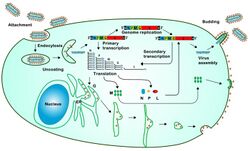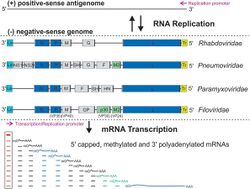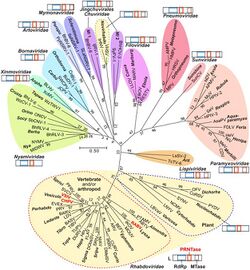Biology:Mononegavirales
| Mononegavirales | |
|---|---|

| |
| Vesicular stomatitis virus (VSV) virion and Mononegavirales genomes | |
| Virus classification | |
| (unranked): | Virus |
| Realm: | Riboviria |
| Kingdom: | Orthornavirae |
| Phylum: | Negarnaviricota |
| Class: | Monjiviricetes |
| Order: | Mononegavirales |
| Families | |
|
see text | |
Mononegavirales is an order of negative-strand RNA viruses which have nonsegmented genomes. Some members that cause human disease in this order include Ebola virus, human respiratory syncytial virus, measles virus, mumps virus, Nipah virus, and rabies virus. Important pathogens of nonhuman animals and plants are also in the group. The order includes eleven virus families: Artoviridae, Bornaviridae, Filoviridae, Lispiviridae, Mymonaviridae, Nyamiviridae, Paramyxoviridae, Pneumoviridae, Rhabdoviridae, Sunviridae, and Xinmoviridae.[1]
Use of term
The order Mononegavirales (pronounced: /ˌmɒnəˌnɛɡəviˈrɑːlɪz/ MON-ə-NEG-ə-vee-RAH-liz) [note 1][2][3] is a virological taxon that was created in 1991[4][5] and amended in 1995,[6] 1997,[7] 2000,[8] 2005,[9] 2011,[2] 2016,[10] 2017,[11] and 2018.[1] The name Mononegavirales is derived from the Ancient Greek adjective μóνος monos (alluding to the monopartite and single-stranded genomes of most mononegaviruses), the Latin verb negare (alluding to the negative polarity of these genomes), and the taxonomic suffix -virales (denoting a viral order).[3]
Order inclusion criteria
A virus is a member of the order Mononegavirales if[2][3]
- its genome is a linear, typically (but not always) nonsegmented, single-stranded, non-infectious RNA of negative polarity; possesses inverse-complementary 3' and 5' termini; and is not covalently linked to a protein;
- its genome has the characteristic gene order 3'-UTR–core protein genes–envelope protein genes–RNA-dependent RNA polymerase gene–5'-UTR (3'-N-P-M-G-L-5') (there are, however, some exceptions);
- it produces 5–10 distinct mRNAs from its genome via polar sequential transcription from a single promoter located at the 3' end of the genome; mRNAs are 5' capped and polyadenylated;
- it replicates by synthesizing complete antigenomes;
- it forms infectious helical ribonucleocapsids as the templates for the synthesis of mRNAs, antigenomes, and genomes;
- it encodes an RNA-dependent RNA polymerase (RdRp, L) that is highly homologous to those of other mononegaviruses; and/or
- it typically (but not always) produces enveloped virions with a molecular mass of 300–1,000×106; an S20W of 550–>1,045; and a buoyant density in CsCl of 1.18–1.22 g/cm3.
Life cycle

The mononegavirus life cycle begins with virion attachment to specific cell-surface receptors, followed by fusion of the virion envelope with cellular membranes and the concomitant release of the virus nucleocapsid into the cytosol. The virus RdRp partially uncoats the nucleocapsid and transcribes the genes into positive-stranded mRNAs, which are then translated into structural and nonstructural proteins.[9]
Mononegavirus RdRps bind to a single promoter located at the 3' end of the genome. Transcription either terminates after a gene or continues to the next gene downstream. This means that genes close to the 3' end of the genome are transcribed in the greatest abundance, whereas those toward the 5' end are least likely to be transcribed. The gene order is therefore a simple but effective form of transcriptional regulation. The most abundant protein produced is the nucleoprotein, whose concentration in the cell determines when the RdRp switches from gene transcription to genome replication.[9]
Replication results in full-length, positive-stranded antigenomes that are in turn transcribed into negative-stranded virus progeny genome copies. Newly synthesized structural proteins and genomes self-assemble and accumulate near the inside of the cell membrane. Virions bud off from the cell, gaining their envelopes from the cellular membrane they bud from. The mature progeny particles then infect other cells to repeat the cycle.[9]
Paleovirology
Mononegaviruses have a history that dates back several tens of million of years. Mononegavirus "fossils" have been discovered in the form of mononegavirus genes or gene fragments integrated into mammalian genomes. For instance, bornavirus gene "fossils" have been detected in the genomes of bats, fish, hyraxes, marsupials, primates, rodents, ruminants, and elephants.[12][13][14][15][16] Filovirus gene "fossils" have been detected in the genomes of bats, rodents, shrews, tenrecs, and marsupials.[13][14][17][18] A Midway virus "fossil" was found in the genome of zebrafish.[13] Finally, rhabdovirus "fossils" were found in the genomes of crustaceans, mosquitoes, ticks, and plants.[19][14][20][21]
Taxonomy
The order has eleven families that include numerous genera, which consist of many different species:[citation needed]
- Artoviridae
- Bornaviridae
- Filoviridae
- Lispiviridae
- Mymonaviridae
- Nyamiviridae
- Paramyxoviridae
- Pneumoviridae
- Rhabdoviridae
- Sunviridae
- Xinmoviridae
Table of the order showing all families, genera, species, and their viruses:[1]
Table legend: "*" denotes type species.
Notes
- ↑ According to the rules for taxon naming established by the International Committee on Taxonomy of Viruses (ICTV), the name Mononegavirales is always to be capitalized, italicized, and never abbreviated. The names of the order's physical members ("mononegaviruses" or "mononegavirads") are to be written in lower case, are not italicized, and used without articles.
References
- ↑ 1.0 1.1 1.2 "Taxonomy of the order Mononegavirales: update 2018". Archives of Virology 163 (8): 2283–2294. April 2018. doi:10.1007/s00705-018-3814-x. PMID 29637429.
- ↑ 2.0 2.1 2.2 "Order Mononegavirales". Virus Taxonomy—Ninth Report of the International Committee on Taxonomy of Viruses. London, UK: Elsevier/Academic Press. 2011. pp. 653–657. ISBN 978-0-12-384684-6. https://archive.org/details/virustaxonomyixt00king.
- ↑ 3.0 3.1 3.2 "Proposal for a revised taxonomy of the family Filoviridae: classification, names of taxa and viruses, and virus abbreviations". Archives of Virology 155 (12): 2083–103. December 2010. doi:10.1007/s00705-010-0814-x. PMID 21046175.
- ↑ Pringle, C. R. (1991). "The order Mononegavirales". Archives of Virology 117 (1–2): 137–40. doi:10.1007/BF01310499. PMID 2006902.
- ↑ "Order Mononegavirales". Classification and Nomenclature of Viruses-Fifth Report of the International Committee on Taxonomy of Viruses. Archives of Virology Supplement, vol. 2. Vienna, Austria: Springer. 1991. pp. 239–41. ISBN 978-0-387-82286-0.
- ↑ "Order Mononegavirales". Virus Taxonomy—Sixth Report of the International Committee on Taxonomy of Viruses. Archives of Virology Supplement. 10. Vienna, Austria: Springer. 1995. pp. 265–267. ISBN 978-3-211-82594-5.
- ↑ "The order Mononegavirales--current status". Archives of Virology 142 (11): 2321–6. 1997. PMID 9672597.
- ↑ "Order Mononegavirales". Virus Taxonomy—Seventh Report of the International Committee on Taxonomy of Viruses. San Diego, USA: Academic Press. 2000. pp. 525–530. ISBN 978-0-12-370200-5.
- ↑ 9.0 9.1 9.2 9.3 "Order Mononegavirales". Virus Taxonomy—Eighth Report of the International Committee on Taxonomy of Viruses. San Diego, USA: Elsevier/Academic Press. 2005. pp. 609–614. ISBN 978-0-12-370200-5.
- ↑ "Taxonomy of the order Mononegavirales: update 2016". Archives of Virology 161 (8): 2351–60. August 2016. doi:10.1007/s00705-016-2880-1. PMID 27216929.
- ↑ "Taxonomy of the order Mononegavirales: update 2017". Archives of Virology 162 (8): 2493–2504. August 2017. doi:10.1007/s00705-017-3311-7. PMID 28389807.
- ↑ "Endogenous non-retroviral RNA virus elements in mammalian genomes". Nature 463 (7277): 84–7. January 2010. doi:10.1038/nature08695. PMID 20054395. Bibcode: 2010Natur.463...84H.
- ↑ 13.0 13.1 13.2 Buchmeier, Michael J., ed (July 2010). "Unexpected inheritance: multiple integrations of ancient bornavirus and ebolavirus/marburgvirus sequences in vertebrate genomes". PLOS Pathogens 6 (7): e1001030. doi:10.1371/journal.ppat.1001030. PMID 20686665.
- ↑ 14.0 14.1 14.2 Malik, Harmit S., ed (November 2010). "Endogenous viral elements in animal genomes". PLOS Genetics 6 (11): e1001191. doi:10.1371/journal.pgen.1001191. PMID 21124940.
- ↑ "Genomic Mining Reveals Deep Evolutionary Relationships between Bornaviruses and Bats". Viruses 7 (11): 5792–800. November 2015. doi:10.3390/v7112906. PMID 26569285.
- ↑ "Paleovirology of bornaviruses: What can be learned from molecular fossils of bornaviruses". Virus Research 262: 2–9. April 2018. doi:10.1016/j.virusres.2018.04.006. PMID 29630909.
- ↑ "Filoviruses are ancient and integrated into mammalian genomes". BMC Evolutionary Biology 10 (1): 193. June 2010. doi:10.1186/1471-2148-10-193. PMID 20569424. Bibcode: 2010BMCEE..10..193T.
- ↑ "Evolutionary maintenance of filovirus-like genes in bat genomes". BMC Evolutionary Biology 11 (1): 336. November 2011. doi:10.1186/1471-2148-11-336. PMID 22093762. Bibcode: 2011BMCEE..11..336T.
- ↑ "Comparative paleovirological analysis of crustaceans identifies multiple widespread viral groups". Mobile DNA 6: 16. 2015. doi:10.1186/s13100-015-0047-3. PMID 26388953.
- ↑ Nagy, Peter D, ed (July 2011). "Widespread endogenization of genome sequences of non-retroviral RNA viruses into plant genomes". PLOS Pathogens 7 (7): e1002146. doi:10.1371/journal.ppat.1002146. PMID 21779172.
- ↑ "Fossil rhabdoviral sequences integrated into arthropod genomes: ontogeny, evolution, and potential functionality". Molecular Biology and Evolution 29 (1): 381–90. January 2012. doi:10.1093/molbev/msr226. PMID 21917725.
External links
Wikidata ☰ Q1753162 entry
 |



